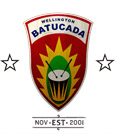What is Samba?
Samba is the rhythm of Brazil, an infectious musical style that emerged from African rhythms brought by the slaves to Bahia and Rio de Janeiro. It’s the heart and soul of Rio de Janeiro, its birthplace. These days you can find samba groups all over the world, such is the popularity of this vibrant music.
We are now accepting expressions of interest for our 2026 drumming course.
We have recently completed the 2025 beginners’ 6-week drumming course, which ran between July and September this year.
Check out the Join us page to find out more.
Batucada members – instructional videos are here (you need to be logged-in).
Highlights of our main stage performance at CubaDupa 2018.
Video footage by John Conly and Michael Sloley, compiled by Michael Sloley.
Developed in Escolas de Samba (Samba Schools), samba is inseparable from the Carnaval and the samba schools compete fiercely in it each year to win the coveted first place. Samba is the ‘popular art’ of the people, and samba schools are important social structures in a world that can be very uncertain if you are not wealthy. They are inclusive and everyone has a place. We have the same philosophy at Wellington Batucada – everyone is welcome to join.
Samba music is in 2/4 time with a high bass drum beat on the first beat, a lower foundation beat on the second beat, and highly syncopated rhythms played over the top. A bateria plays the rhythmical part, while melody instruments and singers play the tunes. In Wellington Batucada we focus on the rhythmical aspects of samba, and play a range of traditional Brazilian percussion instruments.
The band plays Maxixe at CubaDupa 2016 – video by Bella Obi
There is a wide variety of types and sub-styles of samba. These include: batucada, maracatu, afoxé, samba reggae, forró, pagode, samba de roda, samba-canção, and bossa nova. At Wellington Batucada we play a range of different styles, and are always enthusiastic about increasing our repertoire by learning from the samba mestres who visit us from overseas.
Performing Funkanui, Sevens Waterfont Parade 2015 – video by Fernando Maluf
Our instruments
In Wellington Batucada we play nine different percussion instruments. Click on any image to see a larger version:
Tamborim
 The tamborim is a small 6″ drum held in one hand and played using a plastic multi-stranded stick while rapidly twisting the drum to change its position. It looks a bit like a tambourine without the jingles.
The tamborim is a small 6″ drum held in one hand and played using a plastic multi-stranded stick while rapidly twisting the drum to change its position. It looks a bit like a tambourine without the jingles.
The tamborim is one of the more technically challenging instruments, and is tricky to master. It’s played at high speed and provides a high-pitched accent pattern, often complementing or counterpointing the agogos.
Tams and agogos are the most visible instruments as they share the front row, hence their unofficial Wellington Batucada title of “show ponies”.
Agogo
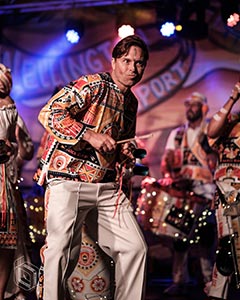 The agogo is a U-shaped metal rod with an open bell at either end, which is held in one hand and played using a wooden stick.
The agogo is a U-shaped metal rod with an open bell at either end, which is held in one hand and played using a wooden stick.
The agogos and tams, producing the two most high-pitched sounds in the band, will generally either be playing the main rhythm, or providing a counterpoint to this. They also sometimes take it in turns to play, in a call and response format.
Technically straightforward to play, the agogo nonetheless requires a great sense of timing, as its patterns are sometimes played off the beat, or off the “one”. They share “show pony” status with the tams in the front row.
Chocalho (shaker)
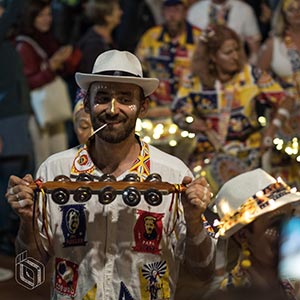 The chocalho, or shaker, is a flat metal or wooden frame filled with pairs of jingles, with a handle at either side. It is played by holding the handles in both hands and shaking the instrument to and fro, following various different patterns and rhythms.
The chocalho, or shaker, is a flat metal or wooden frame filled with pairs of jingles, with a handle at either side. It is played by holding the handles in both hands and shaking the instrument to and fro, following various different patterns and rhythms.
This instrument provides some of the firepower within the band, producing a continuous high-pitched metallic sound that matches very closely with the pattern of the caixas. Chocalho players need to be pretty fit, with heaps of stamina, especially in their arms. It’s a heck of a workout for your upper body!
Timbau
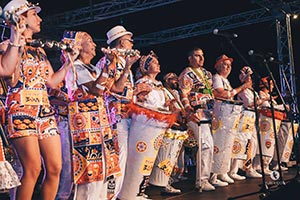 The timbau is a tall hand drum, played using both hands in various positions to create different sounds. It’s worn in front of the body using a harness-like drum strap and looks something like a conga drum.
The timbau is a tall hand drum, played using both hands in various positions to create different sounds. It’s worn in front of the body using a harness-like drum strap and looks something like a conga drum.
The various slaps, hits and tones produced on the timbau can be tricky to get the hang of, and are specific to Brazilian percussion (with some similarities to African hand drums, djembe and conga drums). The timbau’s also quite an unwieldy instrument to play while parading, so if you’re not too tall, make sure you choose a short one!
Caixa (snare drum)
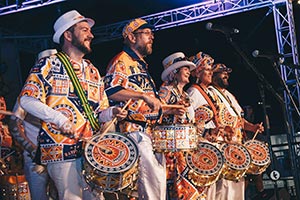 The caixa, or snare drum, is a 12″ drum with guitar strings (the snare) stretched across the top to enhance the sound. It’s worn at an angle on the body, suspended from a drum strap, and played with two wooden drumsticks, using the traditional grip.
The caixa, or snare drum, is a 12″ drum with guitar strings (the snare) stretched across the top to enhance the sound. It’s worn at an angle on the body, suspended from a drum strap, and played with two wooden drumsticks, using the traditional grip.
The caixa is one of the most challenging instruments to master from a technical point of view, partly because of the traditional grip used to hold the sticks, and also because it’s played at high speed. Often all of the sixteenth notes are played by the caixas, with accent notes providing the main pattern and ghost notes filling in the gaps. The caixas are the engine room of the band, and their rhythms often match those of the chocalho.
Repinique
 The repinique is a 12″ drum, taller than the caixa. It’s played with either two plastic sticks or one wooden stick and the other hand (depending on the rhythm). It’s worn in front of the body at a lower and straighter position than the caixas, suspended on a drum strap.
The repinique is a 12″ drum, taller than the caixa. It’s played with either two plastic sticks or one wooden stick and the other hand (depending on the rhythm). It’s worn in front of the body at a lower and straighter position than the caixas, suspended on a drum strap.
The repiniques have two jobs – to underpin the main rhythm with a fast continuous beat, and also (very importantly) to “call” in the rest of the band, often signalling the start and end of turns, breaks and pattern changes. It’s no coincidence that our band’s three directors all play repinique as it’s the instrument that leads the rest of us.
First and second surdos
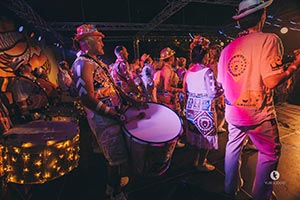 The first surdo or primeira is the largest of our three bass drums. The second surdo or segunda is generally slightly smaller and always tuned slightly higher. These large surdos can be anywhere between 20″ and 26″ across, and of varying heights.
The first surdo or primeira is the largest of our three bass drums. The second surdo or segunda is generally slightly smaller and always tuned slightly higher. These large surdos can be anywhere between 20″ and 26″ across, and of varying heights.
Surdos are worn in front of the body using either a shoulder or waist strap. They are played with a single beater, with the other hand placed intermittently on the drum head to deaden the sound and keep time with the surdos opposite. The first surdo plays the accent on the “two”, and the second surdo plays on the “one”.
In a Brazilian bateria, you wouldn’t be allowed to touch the two big surdos until you’d been playing other instruments in the band for many years. Although they may look simple to play (and technically, they are), with the big surdos timing is everything. When you play these drums you are keeping time for the whole of the rest of the band, so your job couldn’t be more important. If you’ve got great timing and you’re reasonably strong, this could be the drum for you.
Third surdo
 The third surdo or terceira is the smallest and tuned the highest of the three surdos. The drums are generally around 16-20″ across, and of varying heights. Third surdos are also worn in front of the body using either a shoulder or waist strap.
The third surdo or terceira is the smallest and tuned the highest of the three surdos. The drums are generally around 16-20″ across, and of varying heights. Third surdos are also worn in front of the body using either a shoulder or waist strap.
These drums are played with either two beaters or one beater and the other hand (depending on the rhythm). The thirds play more complex patterns that provide fills and syncopations, producing an effect of “cutting” across the basic pulse created by other two surdos. It’s a great one to choose if you want the fun of bashing away on a big drum and getting to play a few different patterns at the same time.
BATUCADA MEMBERS – if you are looking for our training videos for each instrument and each performance piece, you need to go to the Blog section and make sure you’re signed in. There’s a members-only menu where you will find all our instructional videos and information about how to play each piece.
Definitions
Batucada
The simple definition of Batucada would be a percussion jam session, but that doesn’t begin to describe the awesome power a tight ensemble is capable of producing. Percussion is the bare bones of samba, but the larger bateria (percussion group) ensembles within the samba schools make breathtakingly complex walls of sound. The throbbing heartbeat of the surdo drum (somewhere between a bass drum and a tom-tom) underpins rattling snares, layers of hand-held percussion instruments such as agogôs (bells), ganzás (metal tubes filled with beads that you shake), tambourims (a bit like small tambourines which you hit with a split stick), and the panting, surreal shrieks and moans of the cuíca, a friction drum.
Samba! Wellington Batucada plays WOMAD 2015
Video by Kirsty Brewin
Escolas de Samba (Samba Schools)
A social, cultural, and club group that meets regularly and frequently with the purpose of learning and performing Brazilian samba dance, music, and costumes. It is a family organisation that hands samba and Brazilian culture down from generation to generation with the main goal of performing spectacular carnival parades during Carnaval each year (occurring during the Lent season).
At a minimum a school must have: a bateria (percussion group), groups of baianas, flag of the school carried by porta-bandeira and mestre-sala, child participants, and a theme song (Sambas de Enredo) written each year for Carnaval and performed and played by the school participants.
The term “samba school” actually comes from the fact that the first such groups met on school property in the early part of the 20th century in Brazil.
The great samba parades of Rio de Janeiro are all put on and performed by samba schools.
Bateria
The driving force of the groups is the bateria. This is an array of drummers and other percussionists led by a director, or mestre, who conducts and signals with whistles the various breaks, solos, whoops and hollers which can all add up to a delicious assault on the senses.
Sambista
A person who takes part in the activities of a samba group or a samba school. Dancers (pasistas) and percussionists (ritmistas) are sambistas.
Enredo
The theme of a samba parade. These are usually lofty, poetic descriptions of a subject that interests Brazilians such as politics, the environment, a famous person, etc.
Carnaval
The word “Carnaval” is derived from the Latin and refers to the penitential renunciation of meat and other robust pleasures during Lent. Catholic and Yoruba-based African rituals co-exist amicably in Brazil, but the ancient Christian tradition of modestly indulging the senses prior to forty days of fasting and penance somehow got just a bit out of hand. At Carnaval time, Christianity bides its time until contrition sets in, and the hung-over masses totter off to make their no doubt astounding confessions before Easter.
The Rio de Janeiro Carnaval is the world’s biggest and rowdiest party and must be experienced to be believed, but has become rampantly commercial over the years. Nonetheless, a head-on encounter with a Desfile (samba school on parade) is like being engulfed by a conquering army of total strangers who really want to make friends! To get an idea of what the Rio Carnaval was like before its present incarnation, we recommend the film Orfeo Negro (Black Orpheus). Another option is to attend Carnaval somewhere other than in Rio. Salvador, the capital city of the northeastern state of Bahia, holds especially wondrous revels, but there are several local bashes around the country well worth checking out.
(Thanks to Rhythmbash for the info.)
